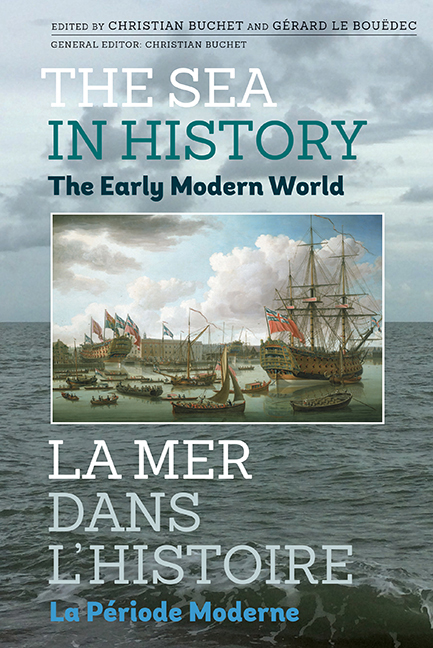Book contents
- Frontmatter
- Contents
- List of Illustrations
- List of Contributors
- Introduction générale et remerciements par
- General introduction and acknowledgements
- Introduction (français)
- Introduction (English)
- LA RÉUSSITE PAR LA MER:La reussite par la mer des territoires et des communautés littorales
- La construction d'un espace mondial: La circulation maritime et les ports
- La forte croissance de l'économie des pêches et des échanges
- Les acteurs de la dynamique maritime
- LA PUISSANCE MARITIME INSTRUMENT DE LA PUISSANCE POLITIQUE ET D'UNE STRATÉGIE GLOBALE DE RAYONNEMENT VOIRE DE DOMINATION: Les puissances maritimes occidentales
- L'ordre des Hospitaliers de Saint-Jean de Jérusalem, Rhodes et Malte, puissance maritime
- Portugal, the west seafront of Europe
- Les formes complexes de la prédominance de l'Espagne, première puissance mondiale de l'histoire
- Le maritime, fondement de la prédominance commerciale et économique des Provinces-Unies
- The keys to British success: trade as a motor and sea as a centre
- Le modèle français: la recherche par l'état de la prédominance maritime, réussites et échecs
- L'Europe Centrale et la mer à l'époque moderne
- Swedish and Danish rivalry to become great powers seen through the development of naval and merchant fleets
- Ambiguous relations between Russia and the sea: causes and consequences
- L'océan Indien, entre convoitises et indifférences
- Les puissances maritimes asiatiques
- L'Afrique
- La politique maritime et l'idéologie
- Mer et développement technologique
- Développement maritime et maîtrise économique et financière
- Développement maritime et maîtrise organisationnelle
- Conclusion (français)
- Conclusion (English)
- Conclusion générale par
- General conclusion by
- Miscellaneous Endmatter
- Miscellaneous Endmatter
Swedish and Danish rivalry to become great powers seen through the development of naval and merchant fleets
from LA PUISSANCE MARITIME INSTRUMENT DE LA PUISSANCE POLITIQUE ET D'UNE STRATÉGIE GLOBALE DE RAYONNEMENT VOIRE DE DOMINATION: Les puissances maritimes occidentales
Published online by Cambridge University Press: 11 May 2017
- Frontmatter
- Contents
- List of Illustrations
- List of Contributors
- Introduction générale et remerciements par
- General introduction and acknowledgements
- Introduction (français)
- Introduction (English)
- LA RÉUSSITE PAR LA MER:La reussite par la mer des territoires et des communautés littorales
- La construction d'un espace mondial: La circulation maritime et les ports
- La forte croissance de l'économie des pêches et des échanges
- Les acteurs de la dynamique maritime
- LA PUISSANCE MARITIME INSTRUMENT DE LA PUISSANCE POLITIQUE ET D'UNE STRATÉGIE GLOBALE DE RAYONNEMENT VOIRE DE DOMINATION: Les puissances maritimes occidentales
- L'ordre des Hospitaliers de Saint-Jean de Jérusalem, Rhodes et Malte, puissance maritime
- Portugal, the west seafront of Europe
- Les formes complexes de la prédominance de l'Espagne, première puissance mondiale de l'histoire
- Le maritime, fondement de la prédominance commerciale et économique des Provinces-Unies
- The keys to British success: trade as a motor and sea as a centre
- Le modèle français: la recherche par l'état de la prédominance maritime, réussites et échecs
- L'Europe Centrale et la mer à l'époque moderne
- Swedish and Danish rivalry to become great powers seen through the development of naval and merchant fleets
- Ambiguous relations between Russia and the sea: causes and consequences
- L'océan Indien, entre convoitises et indifférences
- Les puissances maritimes asiatiques
- L'Afrique
- La politique maritime et l'idéologie
- Mer et développement technologique
- Développement maritime et maîtrise économique et financière
- Développement maritime et maîtrise organisationnelle
- Conclusion (français)
- Conclusion (English)
- Conclusion générale par
- General conclusion by
- Miscellaneous Endmatter
- Miscellaneous Endmatter
Summary
ABSTRACT. Source of conflicts for the control of the strait and access to the Baltic, the sea was the force of modernity for the Scandinavian states. Until the arrival of the Russian naval force and the founding of Saint Petersburg, it was the basis for the commercial predominance of Denmark and the logistical vector of Swedish military domination on the continent.
RÉSUMÉ. Source de conflits pour le contrôle du détroit et l'accès à la Baltique, la mer a été le moteur de la modernité des Etats scandinaves. Elle fut, jusqu'à l'avènement de la puissance navale russe avec l'établissement de Saint-Pétersbourg, le fondement de la prédominance commerciale du Danemark et le vecteur logistique de la domination militaire suédoise sur le continent.
Geography has for obvious reasons played a large role in the creation of maritime powers. Easy access to important waterways coupled with equally easy access to necessary natural resources like timber, hemp and tar were essential for establishing the maritime states of early modern Europe. The Baltic Sea region was in a unique position as a launching point for establishing a maritime great power in the early modern period. There were plenty of good, natural harbours to accommodate both trade and warfare. The sea in the Baltic is mostly calm, and the sea lanes served as the most important infrastructure in the region – even if there was a problem with ice during the wintertime. The Pomeranian coniferous forests provided large naturally grown masts and spars. Oak trees grown along the Baltic coast were well suited for the building of wooden warships. The fertile farmland of the southern Baltic in Denmark and the province of Scania (Skåne) provided ample supplies for port cities and maritime communities.
Out of the Viking age and the medieval period gradually emerged two recognizable maritime states, Denmark and Sweden. Denmark was from the beginning a feudal state with a well-defined power base. Once conversion to Christianity had taken place, both Sweden and Denmark engaged in a number of crusades in the Baltic. These crusades were combined maritime operations under direction of the king and his bishops.
- Type
- Chapter
- Information
- The Sea in History - The Early Modern World , pp. 496 - 508Publisher: Boydell & BrewerPrint publication year: 2017



